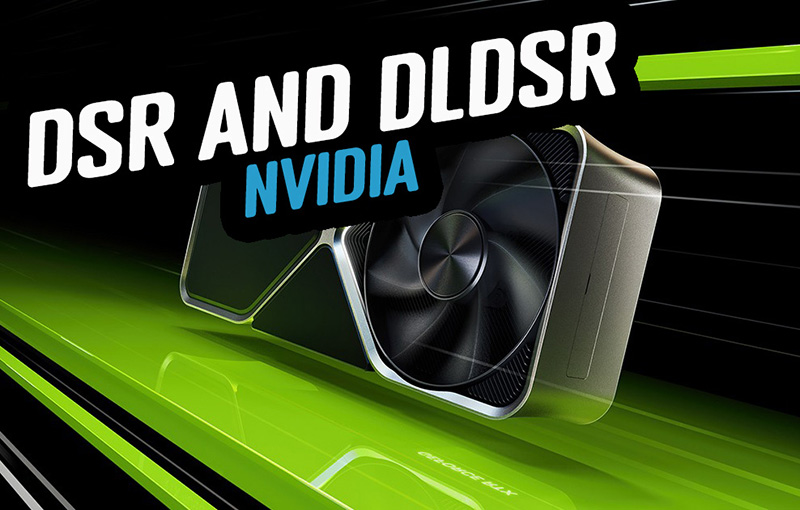NVIDIA DSR and DLDSR do Work with DSC Monitors…Sometimes

This is a topic we’ve seen come up a fair bit recently, and something we wanted to look in to a bit more. In case you’re unfamiliar with the many acronyms in the title, NVIDIA’s DSR technology stands for “Dynamic Super Resolution”. It’s a technology that was launched in early 2022 and basically renders a game at a higher, more detailed resolution and intelligently shrinks the result back down to the resolution of your monitor, giving you “4K-quality graphics on an HD screen” as they put it. It was introduced as part of their Maxwell architecture amongst a range of other features and you can find lots more information about it on NVIDIA’s site, and of course on websites and YouTube channels more focused on graphics cards than we are.
Later on NVIDIA released DLDSR which stands for “Deep Learning Dynamic Super Resolution” which does basically the same thing but relies more on AI / Machine Learning technology to achieve its upscaling, and according to NVIDIA can do this far more efficiently. We aren’t looking to get in to any further detail about what these two graphics card technologies do at this stage, we’d encourage you to read more about them online if you want to know more. Hopefully though you can understand the attraction of these modern graphics card features, and why some gamers may well want to make use of them.
When DSR / DLDSR is most relevant

The marketing and press information about these technologies are heavily weighted towards their benefit when using a 1080p monitor, but upscaling the input signal to 4K first for added detail and clarity. There’s a decent benefit in doing that, and also there’s a reasonable benefit if you had a 1440p monitor where you were upscaling the input source to 4K there too.
This is actually a lot less relevant on a typical monitor sized panel (27 – 32″) that has a native 4K (3840 x 2160) resolution though, as it is already natively 4K, and has a high pixel density too. In theory you could use the technologies here to push beyond 4K but with the panel already offering a high resolution and density natively, its a lot less relevant. It could perhaps be useful if your display was a larger size TV which had a 4K resolution but a lower pixel density. There might be more benefit then in upscaling the resolution further to enhance detail and sharpness. In the monitor market, assuming a typical screen size for a 4K screen, there’s much less benefit than when considering the lower resolution monitors.
There is no benefit by the way in running a 4K screen at a lower resolution and using DSR to upscale to 4K, you might as well just run the screen at 4K natively which should be equally / less demanding on your system anyway.
Using these NVIDIA features with a DSC monitor
The part we wanted to explore was the fact that NVIDIA’s ‘Support Reference Chart‘ published 29/3/22 for both technologies currently says that these technologies do not work with a monitor that needs to use DSC, which stands for “Display Stream Compression” (see below screenshot). That’s a critical point in today’s modern monitor market, where high resolutions and refresh rates almost always need DSC to function and to allow the bandwidth to fit within current video connections like DisplayPort 1.4 and HDMI 2.1. That may change in some cases in the future when DisplayPort 2.1 becomes more widespread, although not necessarily as our recent article discussed. DSC is still a fundamental part of the DisplayPort 2.1 spec, and it looks like it’s a technology that’s here to stay.

That means that if true, the vast majority of top-end monitors could not be used with DSR or DLDSR. However, you don’t have to go far to read lots of user comments saying that these features do work on their DSC-enabled monitor. So what’s the reality then when user experience is different from the official statement?

An update on the situation from NVIDIA
We reached out to NVIDIA to check the latest situation on this matter and establish why some DSC monitors seemed to work fine with these technologies, but others didn’t. They confirmed that DSR/DLDSR can work with DSC, but it is variable from one monitor to the next.
They told us that their FAQ will shortly be updated to state the following:
“NVIDIA DSR, NVIDIA DLDSR and NVIDIA Image Scaling are supported when DSC mode is enabled, if the pixel rate needed to drive the display mode does not exceed the GPU’s single head limit. If GPU uses two or more internal heads to drive the display, NVIDIA DSR, NVIDIA DLDSR and NVIDIA Image Scaling are not supported”
Soon to be updated in NVIDIA DSR / DLDSR FAQ
Which leads to the inevitable question of “how do you tell if your DSC monitor will need to use more than a single head limit?” Unfortunately NVIDIA tell us there is no simple rule for an end-user to determine if two heads are needed, as it is highly dependent on internal monitor timings specified in the EDID. As a result, the only real way to know for sure if a DSC-enabled monitor will support these features – if you’re an NVIDIA user of course, and if you want to use them even – is to rely on third party testing and user feedback.
It’s good news that it’s not a hard “no” for DSC monitors though.
We may earn a commission if you purchase from our affiliate links in this article- TFTCentral is a participant in the Amazon Services LLC Associates Programme, an affiliate advertising programme designed to provide a means for sites to earn advertising fees by advertising and linking to Amazon.com, Amazon.co.uk, Amazon.de, Amazon.ca and other Amazon stores worldwide. We also participate in a similar scheme for Overclockers.co.uk, Newegg, Bestbuy , B&H and some manufacturers.
Stay up to date
 |  |  |  |
| Browser Alerts | Follow on X | Subscribe on YouTube | Support Us |
Latest Monthly News Round-up

Popular Trending News
 LG Display Tease New Tandem WOLED Panel Sizes and Specs for 2026 December 19, 2025 In a short promotional video for their latest Primary RGB Tandem WOLED panels, LG Display have teased the forthcoming development of some new panel sizes and specs that we’ve discussed in our roadmaps in the past, but which now appear…
LG Display Tease New Tandem WOLED Panel Sizes and Specs for 2026 December 19, 2025 In a short promotional video for their latest Primary RGB Tandem WOLED panels, LG Display have teased the forthcoming development of some new panel sizes and specs that we’ve discussed in our roadmaps in the past, but which now appear… 1000Hz monitors, RGB-Mini LED, CES teasers, New Releases (Monitor News Round-up, Dec 2025) December 22, 2025 All the latest monitor news and announcements from the last month in one place to stay up to date. Dec 2025 edition
1000Hz monitors, RGB-Mini LED, CES teasers, New Releases (Monitor News Round-up, Dec 2025) December 22, 2025 All the latest monitor news and announcements from the last month in one place to stay up to date. Dec 2025 edition HKC M10 Ultra Announced with the World’s First RGB-Mini LED Backlight December 15, 2025 HKC (HKC Technology) have recently announced the upcoming launch of their M10 Ultra monitor, the World’s first to feature an RGB-Mini LED backlight which offers a range of new capabilities and some potentially impressive performance if it can live up…
HKC M10 Ultra Announced with the World’s First RGB-Mini LED Backlight December 15, 2025 HKC (HKC Technology) have recently announced the upcoming launch of their M10 Ultra monitor, the World’s first to feature an RGB-Mini LED backlight which offers a range of new capabilities and some potentially impressive performance if it can live up… Asus ROG Strix 5K XG27JCG Announced with a 27″ 5K 180Hz Fast IPS Panel and Dual-Mode December 15, 2025 If you are looking for a display which delivers Ultra-clear visuals and smooth and fluid gameplay, look no further than the Asus ROG Strix 5K XG27JCG. This 27” screen built around a ‘Fast IPS’ panel, boasts a 5120 x 2880…
Asus ROG Strix 5K XG27JCG Announced with a 27″ 5K 180Hz Fast IPS Panel and Dual-Mode December 15, 2025 If you are looking for a display which delivers Ultra-clear visuals and smooth and fluid gameplay, look no further than the Asus ROG Strix 5K XG27JCG. This 27” screen built around a ‘Fast IPS’ panel, boasts a 5120 x 2880… Gigabyte MO27Q28G Finally Available in the US December 17, 2025 Originally published 9th Dec 2025, last updated 17th Dec 2025 The eagerly anticipated Gigabyte MO27Q28G has finally appeared in the US to buy, after being launched across other regions like the UK and much of Europe over the last couple…
Gigabyte MO27Q28G Finally Available in the US December 17, 2025 Originally published 9th Dec 2025, last updated 17th Dec 2025 The eagerly anticipated Gigabyte MO27Q28G has finally appeared in the US to buy, after being launched across other regions like the UK and much of Europe over the last couple…
